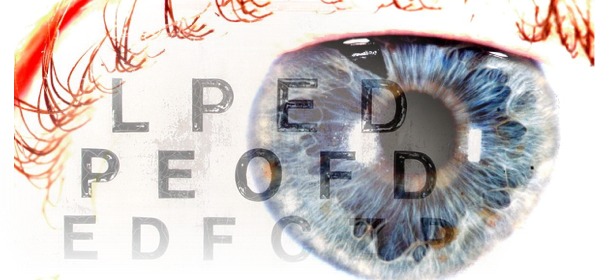Conventional Med
Lasik Surgery: Worse Vision & Never-Ending Pain
The second article Gaia Health produced was on the risks involving Lasik surgery. It’s time to revisit the topic. It would be nice to report that things have gotten better, but they haven’t. The risks still exist, and sadly, it seems that they may be more common than known back in 2009.
by Heidi Stevenson

Eye (cropped) by David Lindes and Eye Chart (cropped and transparency added) by Myki Roventine
Perfect vision without glasses or contacts sounds wonderful. Before considering having Lasik surgery, though, it would be wise to ask how many actually do have good results and how many will suffer bad effects years after Lasik surgery. The advertisements give the impression that it’s a perfectly safe—nearly foolproof—procedure. Nothing could be farther from the truth.
Lasik surgery for vision improvement involves cutting a flap in the eye’s cornea, the clear tissue at the front of the eye, then using a laser to cut and reshape the corneal tissue under the flap. Now, consider that it means cutting through nerves that run directly to the primary optic nerve. What do you suppose happens if it doesn’t heal just right? The result can be chronic unbearable pain, as happened to Colin Dorrian, who committed suicide as a result. Yes, such an extreme outcome is rare—but keep in mind that nearly all lasik surgery is elective, done either for vanity or convenience.
According to Dr. Kerry Soloman, who did a study of Lasik’s safety for the American Society of Cataract and Refractive Surgery, five percent have poor results. He didn’t report it like that. Instead, he reported on how few results are poor. But, keep in mind that the study was financed by the industry itself, so his spin is undoubtedly going to be in favor of his industry. Note that, with hundreds of thousands, possibly millions of people undergoing lasik surgery, that leaves tens of thousands whose results were not so happy.
Bad results can include worse vision—even blindness—constant eye pain, blurred vision, dry eyes, and a variety of other distressing visual aberrations. Interestingly, people who end up with corrected vision but permanent eye pain are considered successes by the surgeons who do the procedure.
More than half of lasik surgery patients suffer from dry eyes at least temporarily after the surgery.1 Because the surgery severs the cornea nerves that stimulate tear production, this has been an obvious and predictable problem.
Estimates of the number of Lasik surgeries performed in the US each year run as high as 4 million, with a low estimate of 700,000.2 With about 5% of them having bad results, that translates to somewhere between 35,000 and 200,000 people who ended up worse, with pain or with visual disturbances, such as double-vision and halos around lights, dry eyes, or other anomalies.
Don’t be too sure of getting accurate results. About 20% of patients don’t, resulting in still needing to wear corrective lenses. Of course, when that happens, the problem is treated lightly. The industry simply calls it “an enhancement”—but that “enhancement” carries all the same risks that the initial surgery did … again. Interestingly, statistics about the results of second lasik surgeries don’t seem to exist, but since the eye is already damaged, it would seem probable that the adverse effects happen more frequently.
Lasik Is Just Another Industry
The Lasik industry is like any other. Its primary motivation is profits, and this one’s are enormous. The following quote is by Dr. Marguerite B. McDonald, the former Chief Medical Editor of EyeWorld, an international publication for ophthalmologists:
We are only starting to ride the enormous growth curve of Lasik in this country. There will be more than enough surgeries for everyone to benefit if we keep our heads by sharing information openly and honestly and by resisting the temptation to criticize the work of our colleagues when we are offering a second opinion to a patient with a suboptimal result.3
She clearly implies that the patients’ welfare is of secondary importance to the doctors’ profits! Dr. McDonald is a major player in the field of Lasik surgery. Think of what this implies about the safety of the process and the dishonesty inherent in many doctors doing it.
Of course, this shouldn’t be surprising. Consider all the ophthalmologists who now specialize in only Lasik surgery. Instead of putting their efforts into procedures that might help people at risk of losing their sight, they have opted to do nothing but provide a risky and unnecessary procedure.
Long Term Results May Include Suicide
Long term results are proving to be even worse. Lawsuits are popping up now as a result of problems developing years later.
Colin Dorrian was a 28-year-old patent lawyer. In the summer of 2007, he killed himself, leaving a note that blamed constant pain from Lasik surgery. He wrote, “I just cannot accept the fact that I’m supposed to live like this.”
Within the industry, there is complete denial of any cause-and-effect between Lasik and suicide. Of course, there have been no studies to see if there’s a connection.
One optometrist, Chistine Sindt, who is also a University of Iowa associate professor of clinical ophthalmology, says that she has seen depression in people with vision problems caused by Lasik. “It’s not just that they lose vision. They paid somebody. . .who took their vision away.”4
Naturally, the Lasik industry explains this sort of thing by saying that the people who become depressed suffered from psychological problems before the surgery. One would think, though, that any doctor whose first interest is in the patient’s welfare would want to err on the side of caution. Instead, though, there has been denial.
Permanent Pathological Changes in All Lasik Patients
In a study published by Cornea in January 2005, it was reported that, of 25 post-mortem Lasik patients, every single one of them had suffered pathological corneal changes that were permanent. There were no exceptions. These patients had died between 3 months and 7 years after their surgeries, and the only determinant for selecting a case for examination was that the person’s visual status prior to the surgery was known.5
Corneas Do Not Heal Completely After Lasik
In the September-October issue of the Journal of Refractive Surgery, a report of a study on the healing of Lasik patients reported that most do not achieve anywhere near the quality of structure that’s achieved from most corneal wounds. The relative strength of the Lasik-induced wound’s tissues average only 2.4% of normal tissue. Wounds gotten in an accidental manner typically develop scars with 28.1% the strength of normal tissue.
In the Journal of Refractive Surgery’s April 2007 issue, the authors stated, “The Lasik flap once cut may contribute little to the mechanical stability of the cornea and probably never completely adheres to the underlying stromal bed.”6
In Review of Ophthamology, Dr. John Kanellopoulos stated:
There was evidence presented by Emory University’s Henry Edelhauser at this year’s Refractive Surgery Subspecialty Day at the Academy of Ophthalmology meeting that the LASIK flap never actually heals onto the underlying stroma, especially centrally … This was a real eye-opener for me …6
Lasik patients are left with permanently weakened corneas. This means that they are forever at risk of permanent eye damage from relatively minor injuries. Those who are most at risk of suffering permanent damage as a result of Lasik surgery, people who are involved in highly physical sports or jobs, are the ones who are often targeted by the industry. Clearly, the best interests of the patients are not the doctors’ primary concern.
Potential Damage from Lasik Surgery
Lasik surgery has not been in existence for long, less than 20 years. Its long term effects are just becoming known, and there are many reasons to be concerned.
There are some indications that the procedure may induce cataracts. Many people, including relatively young ones, have claimed that cataracts were induced by Lasik surgery. There have not, of course, been any studies to see if there’s a connection.7
In November 2007, EyeNet Magazine, a publication of the American Academy of Ophthalmology, reported ectasia, bulging of the cornea, years after Lasik surgery. Joe McFarland, MD, JD stated:
We are also just now learning of some of the long-term complications of refractive surgery, which are being reflected in new allegations and lawsuits. For example, some patients are developing postrefractive ectasia years after the procedure; this condition not only compromises vision, but also may need to be treated with a corneal transplant.8
At least one case of neuropathy to both optic nerves of a patient was noted by the journal,Opthamology in April 2008. It is surmised that the cause was elevation of intraocular (within the eye) pressure induced by a suction ring device routinely used during Lasik procedures. It resulted in several severe vision defects.
A consistent result of Lasik surgery is that people over age 40 who had been able to see things close to them without glasses suddenly require glasses for reading. They have only exchanged distance-vision glasses for reading glasses.
Lasik surgery changes the cornea’s shape and thickness. As a result, intraocular pressure readings, which are critical for diagnosing glaucoma, become inaccurate. This may result in lost vision from glaucoma that goes undiagnosed.
Many cases of ongoing neurological pain have happened. Nerves are severed when the corneal flap is created, and then the cornea under it ablated by laser, which damages deep-lying corneal nerves. These nerves do not recover normal densities for years.10 Sometimes they never regenerate normally, which can result in permanent debilitating pain. Diagnosis is difficult, and many of these patients are told it’s in their heads, leading to even more trauma as they find themselves labeled with psychiatric diagnoses.9 For these people, the choice of lasik surgery is life destroying.
Do You Want to Take the Risk of Lasik Surgery?
Laser sounds so much safer than a knife, but keep in mind that it cuts as sharply as any weapon. One of the primary processes of Lasik surgery is melting part of the cornea to make it smooth. The result is that even the best possible outcome results in poor healing, leaving all patients at significantly greater risk of permanent eye damage from injury. Aside from the immediate risks of seriously impaired vision and permanent eye pain, the long term risks are only beginning to coming to light.
Is Lasik surgery worth the risk? I’ll leave that up to you.
Sources:
- LASIK-associated dry eye and neurotrophic epitheliopathy: pathophysiology and strategies for prevention and treatment. Journal of Refractive Surgery, Ambrósio R Jr, Tervo T, Wilson SE.
- Number of Laser Eye Surgery Procedures Performed
- LASIK Malpractice Lawsuits
- Depression and Suicide After Lasik
- Pathologic Findings in Postmortem Corneas After Successful Laser In Situ Keratomileusis
- Flap Dislocation After Lasik
- Cataracts After Lasik
- FlawedLasik.com
- Corneal Neuropathy | Corneal Neuralgia | Eye Pain After Lasik
- Recovery of corneal subbasal nerve density after PRK and LASIK.
- Ectasia | Keratectasia After Lasik
- Lasik Disaster.com
- Exclusive: Former FDA Regulator Says LASIK Side Effects Weren’t Taken Seriously Enough
- FDA Plans to Examine Scope of Complaints About Lasik
- LASIK complication can include suicide, some say
- Lasik’s Blurry Vision
- Life After Lasik
- Lasik Dangers
Tagged conventional medicine, lasik adverse effects, lasik corneal flap, lasik correction, lasik damage, lasik danger, lasik dangers, lasik dryiness, lasik eye dryness, lasik eye surgery, lasik flap, lasik neuropathy, lasik pain, lasik risks, lasik surgery, modern medicine














Pingback: Homepage